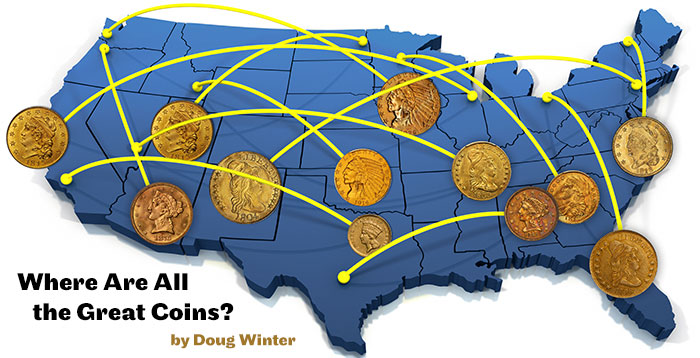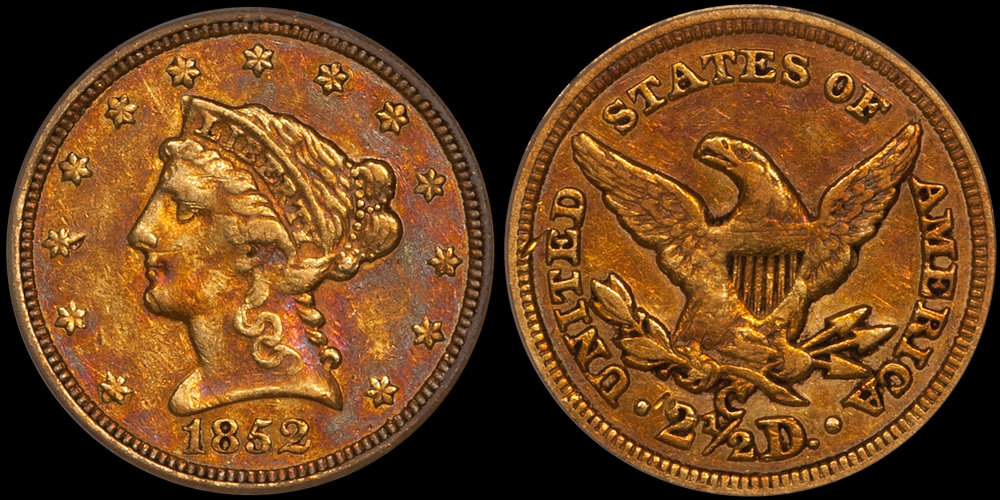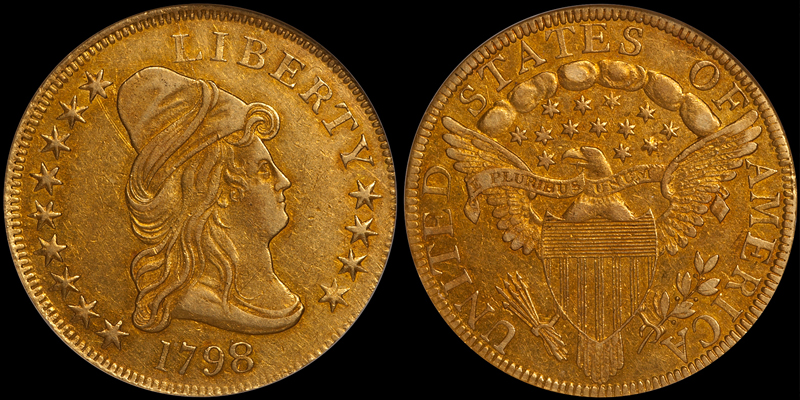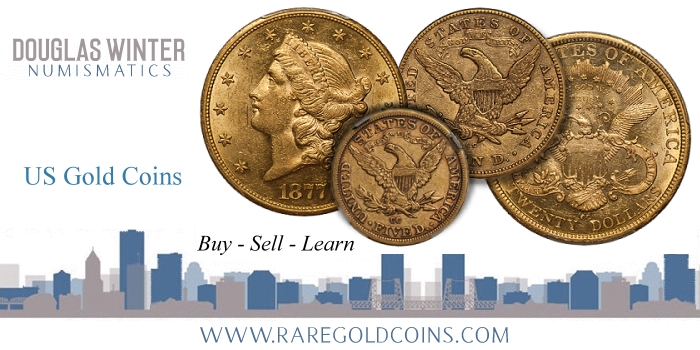
By Doug Winter – RareGoldCoins.com ……
CoinWeek Content Partner ……
I recently read a quote from a well-known dealer who (and I’m paraphrasing) stated that today’s dealer couldn’t build great sets for their clients due to an absence of great coins. While I don’t totally agree with this, I do feel this statement has some merit.
* * *
Before we begin, let’s qualify a big part of the above-referenced statement: What is a great coin?
In my opinion, “great” doesn’t necessarily mean “expensive”. A coin can be great based on its appearance or its rarity. Not all $50,000 coins are “great”, but I would slap this label on a coin like a $3,000 common-date AU50 Dahlonega half eagle with choice original surfaces and natural color.
If you’ve been around the coin business for 30+ years like the dealer I paraphrased above (and me as well…), it does seem that there are fewer great coins around than, say, in the 1980s and ’90s. We didn’t know it at the time but that was a Golden Era (pun intended) for rare gold coin availability.
So why do great coins seem so much harder to locate today? Here are a few reasons:
Doctoring
It pains me to write this but there have been huge numbers of coins ruined by doctoring in the last two to three decades. I place the blame for this on the grading services who rewarded a bright and shiny appearance above originality. With the value spread between grades so high, it was inevitable that a choice EF45 would be stripped and brightened to get into an AU55 holder.
Coins were doctored in the 1880s and ’90s, just not to the extent that they were in the 1980s (and beyond). And coins that were brightened in 1890 have had enough time to regain a pleasing second-generation appearance. It is also important to remember that earlier generations of collectors didn’t focus on rare-date 19th-century gold, meaning that the doctoring process on these coins is “fresher”. Many pre-1834 gold coins have been doctored (not only cleaned but smoothed or recolored) by past generations, but these often have acceptable appearances in today’s market.

1852-C $2.50 PCGS EF45 CAC. Images courtesy Douglas Winter Numismatics
I can remember going to important regional shows in the late 1980s and the early ’90s and coming back with seven or eight really nice crusty Extremely Fine Dahlonega or Charlotte coins. Today, I’m lucky to locate two or three at a major national show. I now pass on 90+% of the dated gold I’m offered due to quality reasons. This was clearly not the case in the past and the blame can squarely be placed on rampant coin doctoring.
There Are More Collectors
While I can’t prove this statistically, I would assume there are more coin collectors in 2019 than there were in 1989 or 1999. If this isn’t a true statement across the board, it is certainly true in the areas in which I specialize.

1854-D $3.00 PCGS AU50 CAC
With a limited supply of great coins, it takes just a small uptick in demand to cause a notable shortage. And this is connected to the point I just made. Today’s collectors of dated gold are more sophisticated than those from the 1980s or the ’90s. This is attributable to the internet, which has made information far more available than in the past. Most collectors in 2019 understand the difference between a mediocre quality 1854-D Three Dollar Gold Piece and a nice one, and most collectors will pass on the schlocky coin and wait for a better specimen.
There are also more “super-collectors” in 2019 than there have been in the past. These are collectors whose sets contain nothing but great coins – often with multiples in the series they specialize in.
Hold Times Are Longer
Back when the market was more investor-oriented, hold times were shorter. Investors were told that, if they held their coins for three to five years, they would make a profit. For a time, this was true. But once the market slowed down, investors left in droves and today we are left with a market that is primarily collector-oriented.
This is mostly a good thing for the market as I feel it is healthy for coins to be regarded more as a collectible with the potential to appreciate in price than as an investment vehicle. But it means that the ownership cycle for many great coins has lengthened. While there are certainly many great coins that bounce around a lot more than they should, many great coins now get held for 10 years or more.

1798/7 9X4 STARS $10.00 NGC AU58 CAC
The Market Is More Efficient
The coin market in 1989, 1999, and even 2009 was extremely inefficient. A dealer might own a great coin but because there were no truly efficient ways to market them, it took longer to sell them. The most efficient way to sell a coin in 1989 was to put it in a Coin World ad, which had a lead time of three weeks. In 1999, if you were on the cutting edge, you sent out a fax list to 25-50 people once a week (mine went out every Sunday night and I can still remember having to enter each recipient by hand and feed each page of the price list into the fax machine). In 2009, the internet had become a factor but it wasn’t totally embraced by the coin market.
Cue to 2019 and the internet is totally pervasive. Coins bought in the morning can be imaged and described and then placed for sale literally a few minutes later. My selling system has become extremely efficient over the last few years, and many of the great coins I list on my site sell within minutes of appearing.
This increase in efficiency means that great coins sell faster than ever in today’s market. Unless you are well-connected with a dealer who handles coins in your specialty, it is harder than ever to buy great pieces.
Can Great Collections Be Built Today?
I’d say the answer is an unequivocal “Yes”, and this can be proven by any number of world-class sets that have been assembled in the last decade. But the market is more competitive than ever, great coins are more expensive than they have ever been, and it is clearly harder to find the right coins, especially if you are a collector doing all the work by yourself.
What are your thoughts about this? Make a comment in the section below or feel free to share an email with me at [email protected].

* * *
About Doug Winter
 Doug has spent much of his life in the field of numismatics; beginning collecting coins at the age of seven, and by the time he was 10 years old, buying and selling coins at conventions in the New York City area.
Doug has spent much of his life in the field of numismatics; beginning collecting coins at the age of seven, and by the time he was 10 years old, buying and selling coins at conventions in the New York City area.
In 1989, he founded Douglas Winter Numismatics, and his firm specializes in buying and selling choice and rare United States coins, especially US gold coins and all branch mint material.
Recognized as one of the leading specialized numismatic firms, Doug is an award-winning author of over a dozen numismatic books and the recognized expert on US Gold. His knowledge and exceptional eye for properly graded and original coins has made him one of the most respected figures in the numismatic community and a sought after dealer by collectors and investors looking for professional personalized service, a select inventory of impeccable quality and fair and honest pricing. Doug is also a major buyer of all US coins and is always looking to purchase collections both large and small. He can be reached at (214) 675-9897.
Doug has been a contributor to the Guidebook of United States Coins (also known as the “Redbook”) since 1983, Walter Breen’s Encyclopedia of United States and Colonial Coins, Q. David Bowers’ Encyclopedia of United States Silver Dollars and Andrew Pollock’s United States Pattern and Related Issues
In addition he has authored 13 books on US Gold coins including:
- Gold Coins of the New Orleans Mint: 1839-1909
- Gold Coins of the Carson City Mint: 1870 – 1893
- Gold Coins of the Charlotte Mint: 1838-1861
- Gold Coins of the Dahlonega Mint 1838-1861
- The United States $3 Gold Pieces 1854-1889
- Carson City Gold Coinage 1870-1893: A Rarity and Condition Census Update
- An Insider’s Guide to Collecting Type One Double Eagles
- The Connoisseur’s Guide to United States Gold Coins
- A Collector’s Guide To Indian Head Quarter Eagles
- The Acadiana Collection of New Orleans Coinage
- Type Three Double Eagles, 1877-1907: A Numismatic History and Analysis
- Gold Coins of the Dahlonega Mint, 1838-1861: A Numismatic History and Analysis
- Type Two Double Eagles, 1866-1876: A Numismatic History and Analysis
Finally Doug is a member of virtually every major numismatic organization, professional trade group and major coin association in the US.




